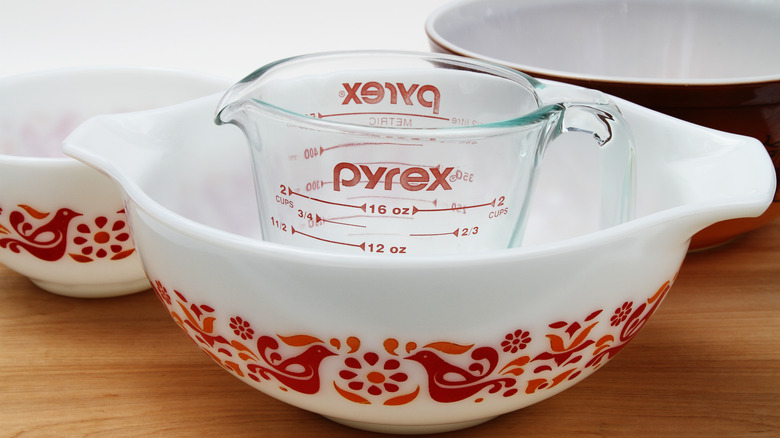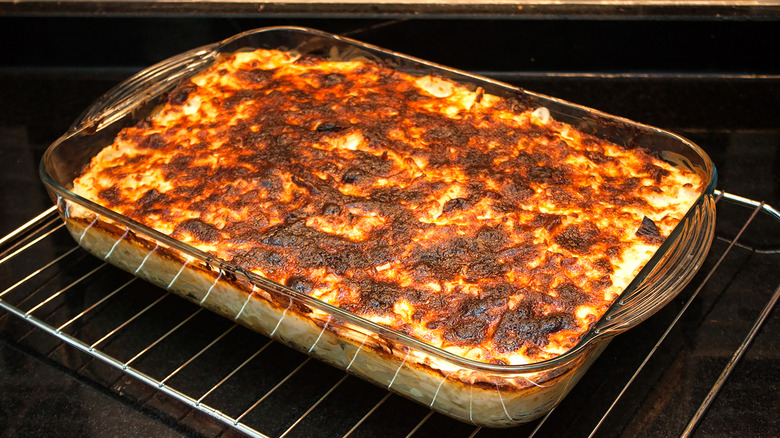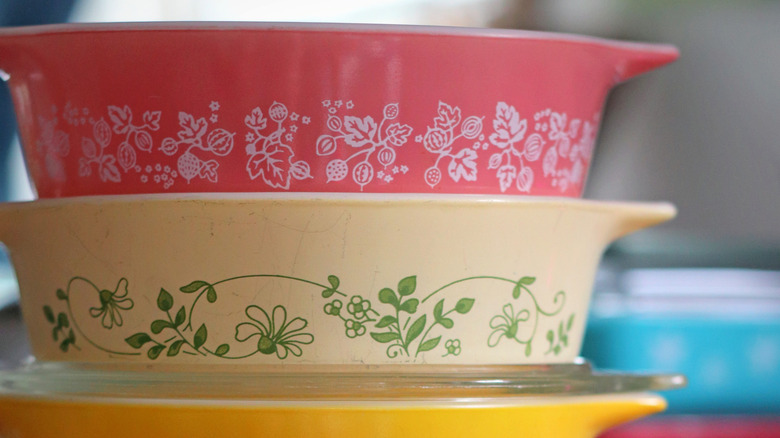Sorry, But Your Beloved Pyrex Might Not Be What You Think It Is
It's more than a dish, it is an icon of cookware innovation. But beyond that, Pyrex containers are a cabinet staple. Whether you own a Pyrex casserole dish, a measuring cup, or have a stack of collectible vintage Pyrex bowls in your curio cabinet, you'd be hard-pressed to escape the impact of the glassware brand in an American kitchen. And for good reason.
The Pyrex brand is known for its heat-resistant glass cookware that allows home chefs to cook dishes evenly and with full visibility. However, not all dishes labeled Pyrex are built equally, and if you use the wrong one, you might just be left with a cracked glass dish. Though Pyrex has become famous for its specialized cook-proof items, not all Pyrex dishes can stand up to the heat. The key to differentiating your Pyrex glassware lies in the labeling. For starters, capital P Pyrex indicates the trademarked brand of glassware that features several different types of glass with varying uses.
Lowercase pyrex, on the other hand, is glassware made by several different companies. Corning, the company that originally owned the trademark for pyrex, sold it, and the name is now used for many different glassware products. Lowercase pyrex dishes are typically made from soda-lime glass, which is standard for cups and containers but is not intended for high heat exposure. This is in contrast to PYREX, in all uppercase, which is made of the signature heat-resistant borosilicate glass. This borosilicate glass is original to Pyrex and is prized among both collectors and cookware enthusiasts. Products labeled PYREX are perfect for cooking and reheating dishes. Though Pyrex may seem to be a uniform label for cookware, there really are a variety of Pyrex products, with varying uses and capabilities.
A revolutionary dish
PYREX, uppercase, is no longer made by the company that initially made the kitchen staple, borosilicate thermal shock-proof glass products. The trademark was sold to a company in Europe, which still makes borosilicate glass under the PYREX name. Therefore, products labeled PYREX are still temperature-resistant and perfect for cooking and reheating dishes. These products can be purchased online and usually indicate their borosilicate glass composition.
This doesn't mean you shouldn't purchase a Pyrex glass casserole dish. Pyrex still makes glass cookware in the American market. But it is now made with tempered glass rather than borosilicate. Tempered glass is more temperature-resistant than soda-lime glass but not quite as resilient as borosilicate glass. And if tempered glass is exposed to rapid temperature changes, it can break. The switch from borosilicate glass to tempered glass in Pyrex cookware was actually made sometime in the second half of the 20th century. Pyrex initially introduced tempered glass products in the 1950s. However, the switch from borosilicate to tempered glass was not uniform, and the exact point at which Pyrex switched entirely to tempered glass is unknown. But that doesn't stop Pyrex enthusiasts from hunting down their favorite, vintage, borosilicate cookware.
From casseroles to collectibles
Just because some Pyrex lines are now a thing of the past, that doesn't mean you can't get your hands on them. It'll just cost you a pretty penny. Vintage Pyrex dishes have become quite the collector's item for fans of midcentury kitsch and home gourmands alike. There are many online groups on platforms such as Facebook that specialize in helping Pyrex collectors find and assess rare and delightful Pyrex pieces.
Many fans of vintage Pyrex prize it for its use of borosilicate glass, which holds up to its sturdy, temperature-proof reputation. A Pyrex dish, if properly cared for, can last through several generations, making for a lovely heirloom. Bringing out an heirloom Pyrex for Thanksgiving dinner can make the holiday even more special. But you might just have to pass a Pyrex dish down through several generations to justify the high price tags that some of the most sought-after Pyrex patterns command. Whether your Pyrex is new or vintage, make sure to double check the label before you pop it in the oven.


